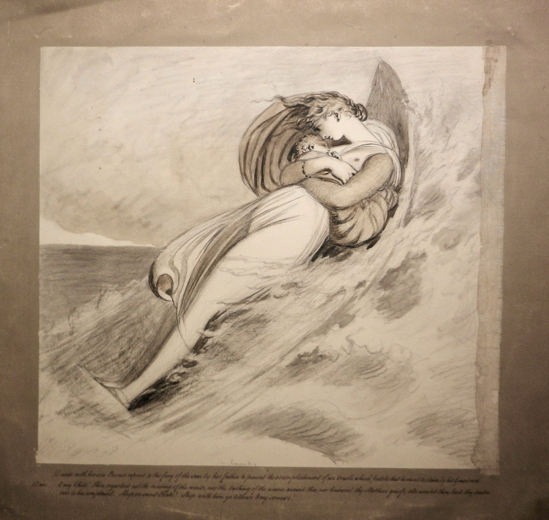Danae and her child Perseus
William Lock the Younger
* 1767 in Norbury † 1847 in Mickleham
Pencil, pen and ink with sepia wash.
Size of sheet: 43.1 x 43.1 cm.
Provenance: Presumably by descent in the family of the 13th Lord Wallscourt, who was married to the artist's daughter Elizabeth.
£3.300.-
William Lock the Younger is a fascinating draughtsman of the early romantic school working in the circle of Henry Fuseli in Rome at the end of the 18th Century.
His father, the noted collector and connoisseur William Locke (1732-1810), formed an important collection of artworks, including Claude Lorrain’s Seaport with the Embarkation of St.Ursula (London, National Gallery), and was the patron of several major artists. He acquired several of Richard Wilson’s drawings recording the journey they made together between Venice and Rome in 1751, as part of Locke’s Grand Tour; when he purchased an estate at Norbury, near Mickleham, Surrey, he employed George Barret and Bartolomeo Cipriani to decorate several rooms; and he was an early supporter of Thomas Lawrence, buying a number of his early works, including a portrait of himself (Boston, Museum of Fine Arts).
William Lock the Younger’s artistic propensity was clearly inherited from his father and his acquaintances. He, too, became a friend of Lawrence, who also recorded his likeness in a sensitive charcoal drawing (New Haven, Yale Centre for British Art). But it was his father’s patronage of Henry Fuseli that proved to have the most enduring influence on his work. The impact of Fuseli’s characteristic style and subject-matter on Lock’s work is easily discernible, first apparent in a group of drawings dating from 1781 and 1782 when Lock was only eleven or twelve years old. A frequent visitor to the house at Norbury, Fuseli dedicated his lectures on painting to his promising young pupil and close friend, praising his “amiability of character and his extensive knowledge… [and] his taste and critical judgment in the fine arts” (Pressly, 1979).
Despite his decision to desist in his desire to become an artist, or certainly a painter, after his own Grand Tour, Lock’s drawings demonstrate the artistic potential and skill that was both recognised by Fuseli and admired by Horace Walpole. His depictions of historical, mythological, biblical and Shakespearean subjects – a wide range of which are present in this exhibition – maintain a uniformity of style which is decidedly his own.
Other examples of Lock’s work may today be seen at the Tate Britain and the Victoria & Albert Museum (London), the Fitzwilliam Museum (Cambridge), the Yale Centre for British Art (New Haven) and the Pierpont Morgan Library (New York).
For further information, see:
Duchess of Sermoneta, The Locks of Norbury: the story of a remarkable family in the XVIIIth and XIXth centuries, 1940.
N.C. Pressly, The Fuseli Circle in Rome. Early Romantic Art of the 1770s, exhibition catalogue, New Haven, Yale Centre for British Art, 1979.
